Fabrication of Long Period Gratings by Periodically Removing the Coating of Cladding-Etched Single Mode Optical Fiber Towards Optical Fiber Sensor Development
Abstract
:1. Introduction
2. Fabrication Process
3. Theoretical Analysis
3.1. Influence of the Diameter of the Fiber
3.2. Influence of the Thickness of the Coating
3.3. Influence of the Grating Period
4. Experimental Results
4.1. Device A
4.2. Device B
4.3. Comparison between Theoretical and Experimental Results
5. Conclusions
Author Contributions
Funding
Acknowledgments
Conflicts of Interest
References
- Vengsarkar, A.M.; Lemaire, P.J.; Judkins, J.B.; Bhatia, V.; Erdogan, T.; Sipe, J.E. Long-period fiber gratings as band-rejection filters. J. Light. Technol. 1996, 14, 58–65. [Google Scholar] [CrossRef]
- Rego, G.; Marques, P.V.S.; Santos, J.L.; Salgado, H.M. Arc-induced long-period gratings. Fiber Integr. Opt. 2005, 24, 245–259. [Google Scholar] [CrossRef]
- Śmietana, M.; Myśliwiec, M.; Mikulic, P.; Witkowski, B.S.; Bock, W.J. Capability for fine tuning of the refractive index sensing properties of long-period gratings by atomic layer deposited Al2O3 overlays. Sensors 2013, 13, 16372–16383. [Google Scholar] [CrossRef]
- Kersey, A.D.; Bucholtz, F.; Patrick, H.J. Analysis of the Response of Long Period Fiber Gratings to External Index of Refraction. J. Light. Technol. 1998, 16, 1606. [Google Scholar]
- Shu, X.; Zhang, L.; Bennion, I. Sensitivity characteristics of long-period fiber gratings. J. Light. Technol. 2002, 20, 255–266. [Google Scholar]
- Coelho, L.; Viegas, D.; Santos, J.L.; Almeida, J.M.M.M. De Enhanced refractive index sensing characteristics of optical fibre long period grating coated with titanium oxide thin films. Sens. Actuators B Chem. 2014, 202, 929–934. [Google Scholar] [CrossRef]
- Singh, A.; Engles, D.; Sharma, A.; Singh, M. Optik Temperature sensitivity of long period fiber grating in SMF-28 fiber. Opt. Int. J. Light Electron Opt. 2014, 125, 457–460. [Google Scholar] [CrossRef]
- James, S.W.; Tatam, R.P.; Twin, A.; Bateman, R.; Noonan, P. Cryogenic temperature response of fibre optic long period gratings. Meas. Sci. Technol. 2003, 14, 1409. [Google Scholar] [CrossRef]
- Wang, Y.-P.; Xiao, L.; Wang, D.N.; Jin, W. Highly sensitive long-period fiber-grating strain sensor with low temperature sensitivity. Opt. Lett. 2006, 31, 3414. [Google Scholar] [CrossRef] [PubMed] [Green Version]
- Bhatia, V.; Vengsarkar, A.M. Optical fiber long-period grating sensors. Opt. Lett. 1996, 21, 692. [Google Scholar] [CrossRef] [PubMed]
- Liu, Y.; Williams, J.A.R.; Bennion, I. Optical bend sensor based on measurement of resonance mode splitting of long-period fiber grating. IEEE Photonics Technol. Lett. 2000, 12, 531–533. [Google Scholar] [CrossRef]
- Rees, N.D.; James, S.W.; Tatam, R.P.; Ashwell, G.J. Optical fiber long-period gratings with Langmuir–Blodgett thin-film overlays. Opt. Lett. 2002, 27, 686. [Google Scholar] [CrossRef] [PubMed]
- DeLisa, M.P.; Zhang, Z.; Shiloach, M.; Pilevar, S.; Davis, C.C.; Sirkis, J.S.; Bentley, W.E. Evanescent Wave Long-Period Fiber Bragg Grating as an Immobilized Antibody Biosensor. Anal. Chem. 2000, 72, 2895–2900. [Google Scholar] [CrossRef] [PubMed]
- Costantini, D.M.; Muller, C.A.P.; Vasiliev, S.A.; Limberger, H.G.; Salathe, R.P. Tunable loss filter based on metal-coated long-period fiber grating. IEEE Photonics Technol. Lett. 1999, 11, 1458–1460. [Google Scholar] [CrossRef]
- Viegas, D.; Goicoechea, J.; Corres, J.M.; Santos, J.L.; Ferreira, L.A.; Araújo, F.M.; Matias, I.R. A fibre optic humidity sensor based on a long-period fibre grating coated with a thin film of SiO2 nanospheres. Meas. Sci. Technol. 2009, 20, 34002. [Google Scholar] [CrossRef]
- Venugopalan, T.; Sun, T.; Grattan, K.T.V. Long period grating-based humidity sensor for potential structural health monitoring. Sens. Actuators A Phys. 2008, 148, 57–62. [Google Scholar] [CrossRef]
- Konstantaki, M.; Pissadakis, S.; Pispas, S.; Madamopoulos, N.; Vainos, N.A. Optical fiber long-period grating humidity sensor with poly(ethylene oxide)/cobalt chloride coating. Appl. Opt. 2006, 45, 4567. [Google Scholar] [CrossRef] [PubMed]
- Corres, J.M.; Matias, I.R.; del Villar, I.; Arregui, F.J. Design of pH Sensors in Long-Period Fiber Gratings Using Polymeric Nanocoatings. IEEE Sens. J. 2007, 7, 455–463. [Google Scholar] [CrossRef]
- Corres, J.M.; del Villar, I.; Matias, I.R.; Arregui, F.J. Fiber-optic pH-sensors in long-period fiber gratings using electrostatic self-assembly. Opt. Lett. 2007, 32, 29. [Google Scholar] [CrossRef] [PubMed]
- Topliss, S.M.; James, S.W.; Davis, F.; Higson, S.P.J.; Tatam, R.P. Optical fibre long period grating based selective vapour sensing of volatile organic compounds. Sens. Actuators B Chem. 2010, 143, 629–634. [Google Scholar] [CrossRef] [Green Version]
- Allsop, T.; Zhang, L.; Bennion, I. Detection of organic aromatic compounds in paraffin by a long-period fiber grating optical sensor with optimized sensitivity. Opt. Commun. 2001, 191, 181–190. [Google Scholar] [CrossRef]
- Gu, Z.; Xu, Y.; Gao, K. Optical fiber long-period grating with solgel coating for gas sensor. Opt. Lett. 2006, 31, 2405. [Google Scholar] [CrossRef] [PubMed]
- Chen, X.; Zhang, L.; Zhou, K.; Davies, E.; Sugden, K.; Bennion, I.; Hughes, M.; Hine, A. Real-time detection of DNA interactions with long-period fiber-grating-based biosensor. Opt. Lett. 2007, 32, 2541. [Google Scholar] [CrossRef] [PubMed] [Green Version]
- Coelho, J.M.P.; Silva, C.; Nespereira, M.; Abreu, M.; Rebordão, J. Writing of Long Period Fiber Gratings Using CO2 Laser Radiation. In Advances in Optical Fiber Technology: Fundamental Optical Phenomena and Applications; InTech: London, UK, 2015. [Google Scholar] [CrossRef]
- Li, B.; Jiang, L.; Wang, S.; Tsai, H.; Xiao, H. Optics & Laser Technology Femtosecond laser fabrication of long period fiber gratings and applications in refractive index sensing. Opt. Laser Technol. 2011, 43, 1420–1423. [Google Scholar]
- Von Bibra, M.L.; Roberts, A. Fabrication of long-period fiber gratings by use of focused ion-beam irradiation. Opt. Lett. 2001, 26, 765–767. [Google Scholar] [CrossRef] [PubMed]
- Park, S.; Kwon, O.J.; Han, Y.G. A novel fabrication technique of corrugated long-period fiber gratings for mass production and its transmission characteristic as applied mechnical force. In Proceedings of the Communications and Photonics Conference and Exhibition (ACP), 2010 Asia, Shanghai, China, 8–12 December 2010; pp. 94–95. [Google Scholar]
- Fu, M.-Y.; Lin, G.-R.; Liu, W.-F.; Sheng, H.-J.; Su, P.-C.; Tien, C.-L. Optical Fiber Sensor Based on Air-Gap Long-Period Fiber Gratings. Jpn. J. Appl. Phys. 2009, 48, 120211. [Google Scholar] [CrossRef]
- Cárdenas-Sevilla, G.A.; Monzón-Hernández, D.; Torres-Gómez, I.; Martínez-Ríos, A. Mechanically induced long-period fiber gratings on tapered fibers. Opt. Commun. 2009, 282, 2823–2826. [Google Scholar] [CrossRef]
- Colaço, C.; Rego, G.; Del Villar, I.; Caldas, P.; Chibante, R. Arc-Induced Long-Period Fiber Gratings in the Dispersion Turning Points. J. Light. Technol. 2016, 34, 4584–4590. [Google Scholar] [CrossRef]
- Chen, K.P.; Herman, P.R.; Tam, R.; Zhang, J. Rapid long-period grating formation in hydrogen-loaded fibre with 157 nm F2-laser radiation. Electron. Lett. 2000, 36, 2000. [Google Scholar] [CrossRef]
- Del Villar, I.; Cruz, J.L.; Socorro, A.B.; Corres, J.M.; Matias, I.R. Sensitivity optimization with cladding-etched long period fiber gratings at the dispersion turning point. Opt. Express 2016, 24, 17680–17685. [Google Scholar] [CrossRef] [PubMed]
- Lemaire, P.J.; Atkins, R.M.; Mizrahi, V.; Reed, W.A. High pressure H2 loading as a technique for achieving ultrahigh UV photosensitivity and thermal sensitivity in GeO2 doped optical fibres. Electron. Lett. 1993, 29, 1191. [Google Scholar] [CrossRef]
- Cui, Z.; Zhang, W.; Liu, F.; Zhang, H.; Bai, Z.; Geng, P.; Gao, S. Asymmetrically corrugated long-period gratings by burning fiber coating and etching cladding. IEEE Photonics Technol. Lett. 2013, 25, 1961–1964. [Google Scholar] [CrossRef]
- Chiang, C.-C.; Chang, H.-J.; Kuo, J.-S. Novel fabrication method of corrugated long-period fiber gratings by thick SU-8 photoresist and wet-etching technique. J. Micro/Nanolithogr. MEMS MOEMS 2010, 9, 33007. [Google Scholar] [CrossRef]
- Liu, Q.; Chiang, K.S.; Rastogi, V. Analysis of corrugated long-period gratings in slab waveguides and their polarization dependence. J. Light. Technol. 2003, 21, 3399–3405. [Google Scholar]
- Ivanov, O.V.; Wang, L.A. Wavelength shifts of cladding-mode resonance in corrugated long-period fiber gratings under torsion. Appl. Opt. 2003, 42, 2264–2272. [Google Scholar] [CrossRef] [PubMed]
- Lin, C.Y.; Wang, L.A.; Chern, G.W. Corrugated long-period fiber gratings as strain, torsion, and bending sensors. J. Light. Technol. 2001, 19, 1159–1168. [Google Scholar]
- Lee, C.-L.; Weng, Z.-Y.; Lin, C.-J.; Lin, Y. Leakage coupling of ultrasensitive periodical silica thin-film long-period grating coated on tapered fiber. Opt. Lett. 2010, 35, 4172–4174. [Google Scholar] [CrossRef] [PubMed]
- Coelho, L.; Viegas, D.; Santos, J.L.; De Almeida, J.M.M.M. Characterization of zinc oxide coated optical fiber long period gratings with improved refractive index sensing properties. Sens. Actuators B Chem. 2016, 223, 45–51. [Google Scholar] [CrossRef] [Green Version]
- Del Villar, I.; Matías, I.R.; Arregui, F.J.; Lalanne, P. Optimization of sensitivity in Long Period Fiber Gratings with overlay deposition. Opt. Express 2005, 13, 56–69. [Google Scholar] [CrossRef] [PubMed]
- Esposito, F.; Ranjan, R.; Campopiano, S.; Iadicicco, A. Influence of Period on Surrounding Refractive Index Sensitivity of Arc-induced Long Period Gratings. Procedia Eng. 2016, 168, 999–1002. [Google Scholar] [CrossRef]
- Hromadka, J.; Korposh, S.; Partridge, M.; James, S.W.; Davis, F.; Crump, D.; Tatam, R.P. Volatile organic compounds sensing using optical fibre long period grating with mesoporous nano-scale coating. Sensors 2017, 17, 205. [Google Scholar] [CrossRef] [PubMed]
- Pilla, P.; Malachovská, V.; Borriello, A.; Buosciolo, A.; Giordano, M.; Ambrosio, L.; Cutolo, A.; Cusano, A. Transition mode long period grating biosensor with functional multilayer coatings. Opt. Express 2011, 19, 512–526. [Google Scholar] [CrossRef] [PubMed]
- Śmietana, M.; Koba, M.; Mikulic, P.; Bock, W.J. Towards refractive index sensitivity of long-period gratings at level of tens of µm per refractive index unit: Fiber cladding etching and nano-coating deposition. Opt. Express 2016, 24, 11897–11904. [Google Scholar] [CrossRef] [PubMed]
- Del Villar, I. Ultrahigh-sensitivity sensors based on thin-film coated long period gratings with reduced diameter, in transition mode and near the dispersion turning point. Opt. Express 2015, 23, 8389. [Google Scholar] [CrossRef] [PubMed]
- James, S.W.; Tatam, R.P. Optical fibre long-period grating sensors: Characteristics and application. Meas. Sci. Technol. 2003, 14, R49–R61. [Google Scholar] [CrossRef]
- Del Villar, I.; Partridge, M.; Rodriguez, W.E.; Fuentes, O.; Socorro, A.B.; Diaz, S.; Corres, J.M.; James, S.W.; Tatam, R.P. Sensitivity Enhancement in Low Cutoff Wavelength Long-Period Fiber Gratings by Cladding Diameter Reduction. Sensors 2017, 17, 2094. [Google Scholar] [CrossRef] [PubMed]
- Allsop, T.; Floreani, F.; Jedrzejewski, K.; Marques, P.; Romero, R.; Webb, D.; Bennion, I. Refractive index sensing with long-period grating fabricated in biconical tapered fibre. Electron. Lett. 2005, 41, 471–472. [Google Scholar] [CrossRef]
- Hale, G.M.; Querry, M.R. Optical Constants of Water in the 200-nm to 200-microm Wavelength Region. Appl. Opt. 1973, 12, 555–563. [Google Scholar] [CrossRef] [PubMed]
- Shu, X.; Zhang, L.; Bennion, I. Fabrication and characterisation of ultra-long-period fibre gratings. Opt. Commun. 2002, 203, 277–281. [Google Scholar] [CrossRef]
- Chiavaioli, F.; Biswas, P.; Trono, C.; Bandyopadhyay, S.; Giannetti, A.; Tombelli, S. Biosensors and Bioelectronics Towards sensitive label-free immunosensing by means of turn-around point long period fi ber gratings. Biosens. Bioelectron. 2014, 60, 305–310. [Google Scholar] [CrossRef] [PubMed]
- Biswas, P.; Basumallick, N.; Bandyopadhyay, S.; Dasgupta, K.; Ghosh, A.; Bandyopadhyay, S. Sensitivity Enhancement of Turn-Around-Point Long Period Gratings by Tuning Initial Coupling Condition. IEEE Sens. J. 2015, 15, 1240–1245. [Google Scholar] [CrossRef]
- Li, Q.S.; Zhang, X.L.; Shi, J.G.; Xiang, D.; Zheng, L.; Yang, Y.; Yang, J.H.; Feng, D.; Dong, W.F. An ultrasensitive Long-Period fiber grating-based refractive index sensor with long wavelengths. Sensors 2016, 16, 2205. [Google Scholar] [CrossRef] [PubMed]
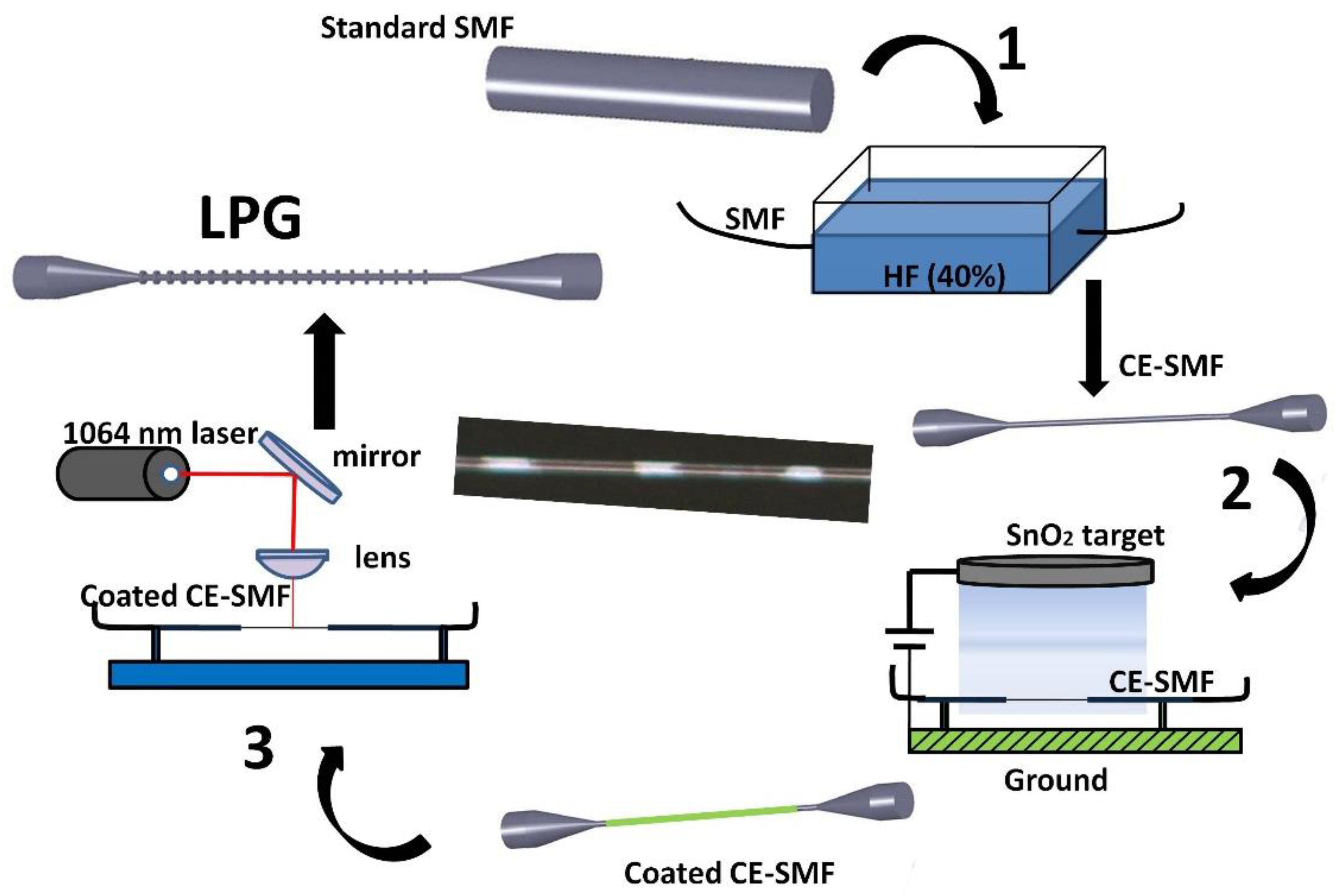
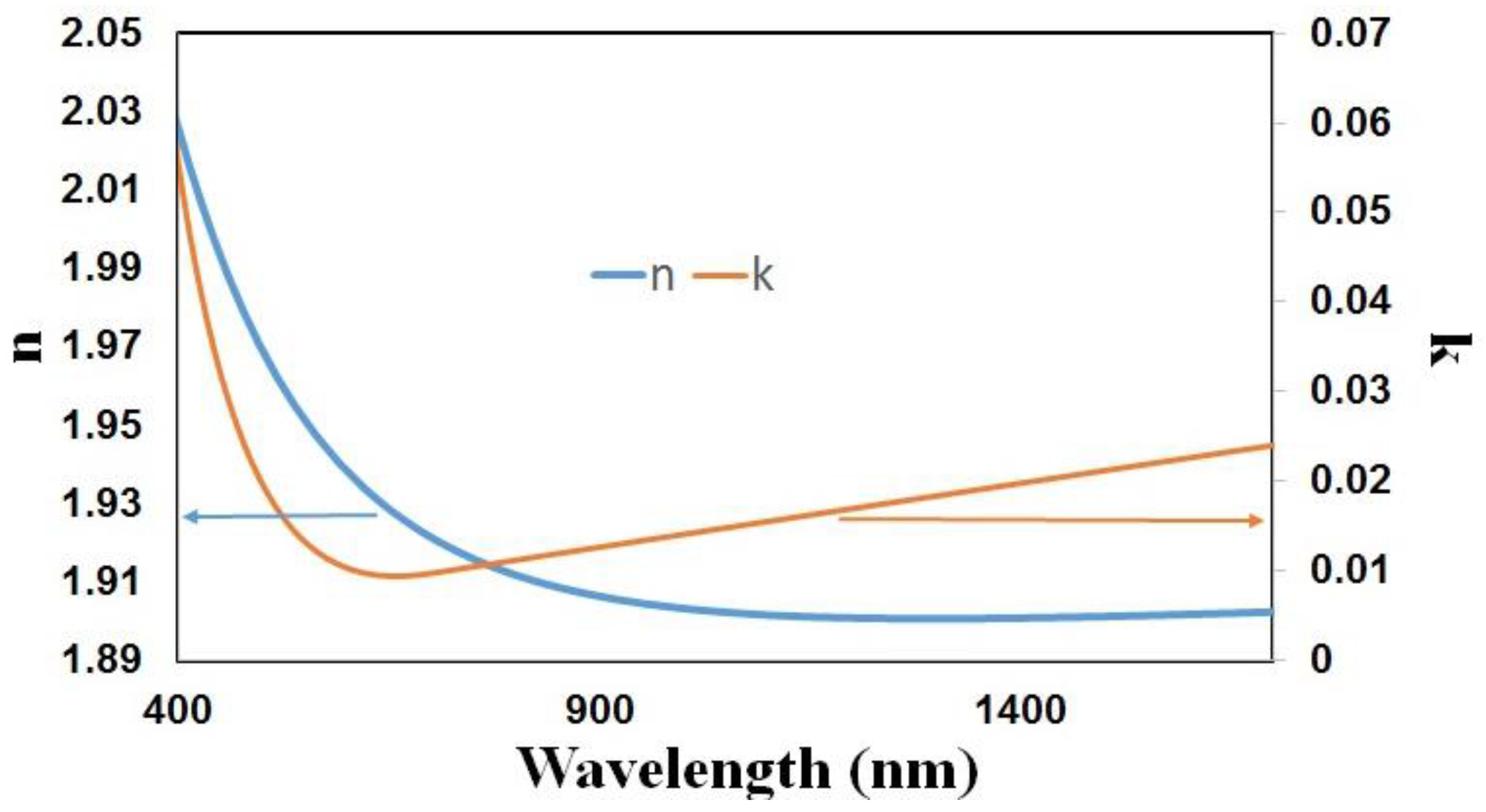


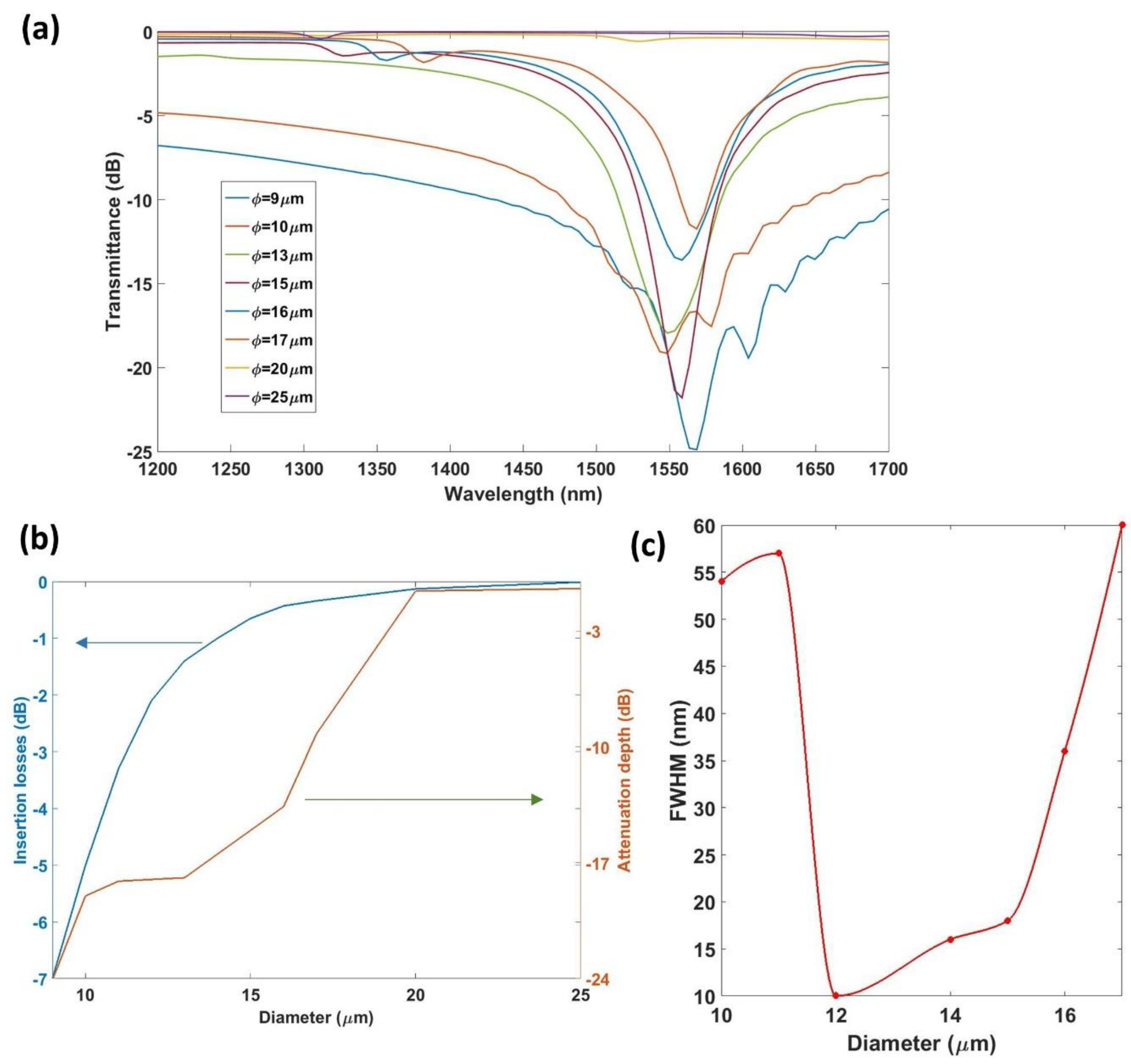


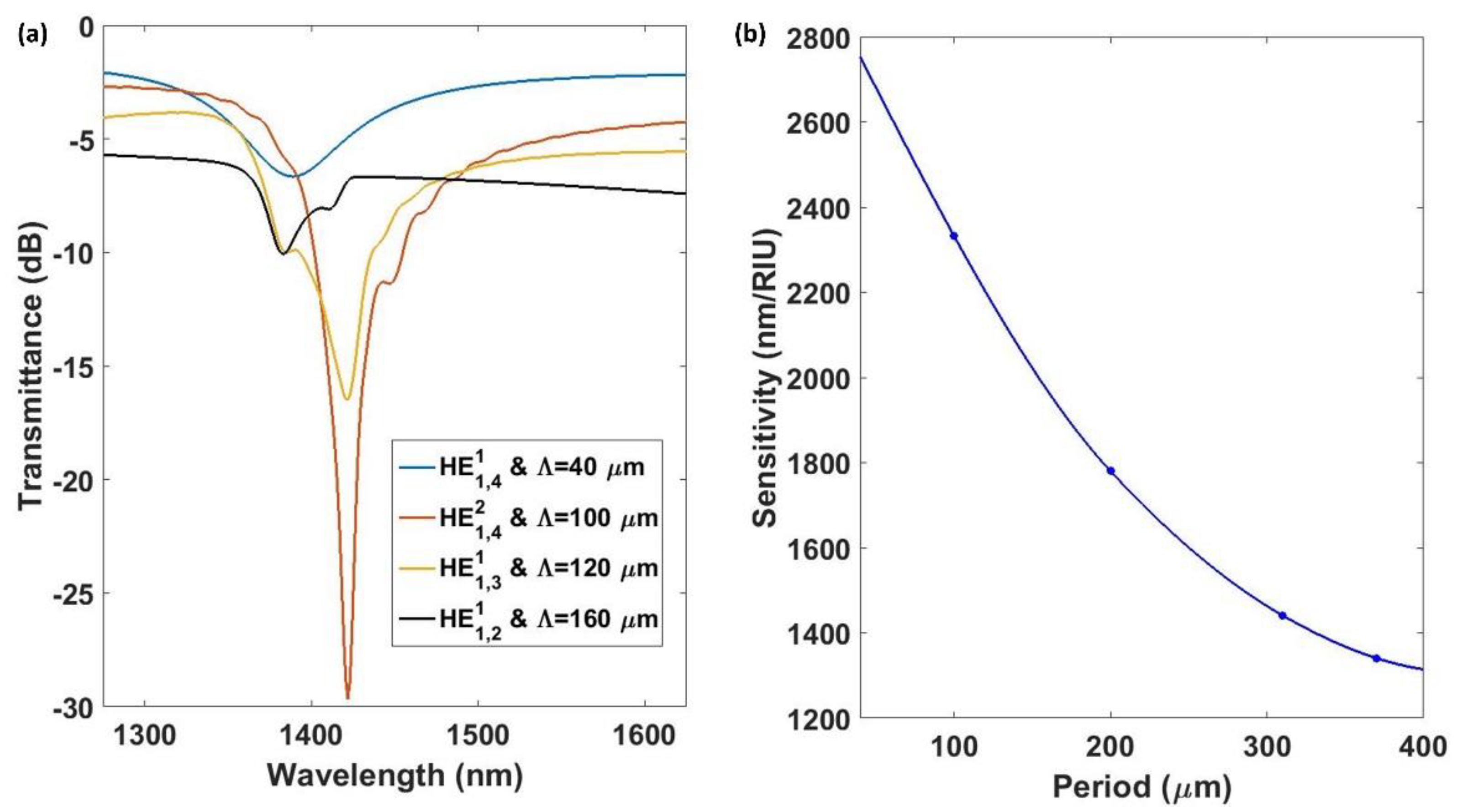
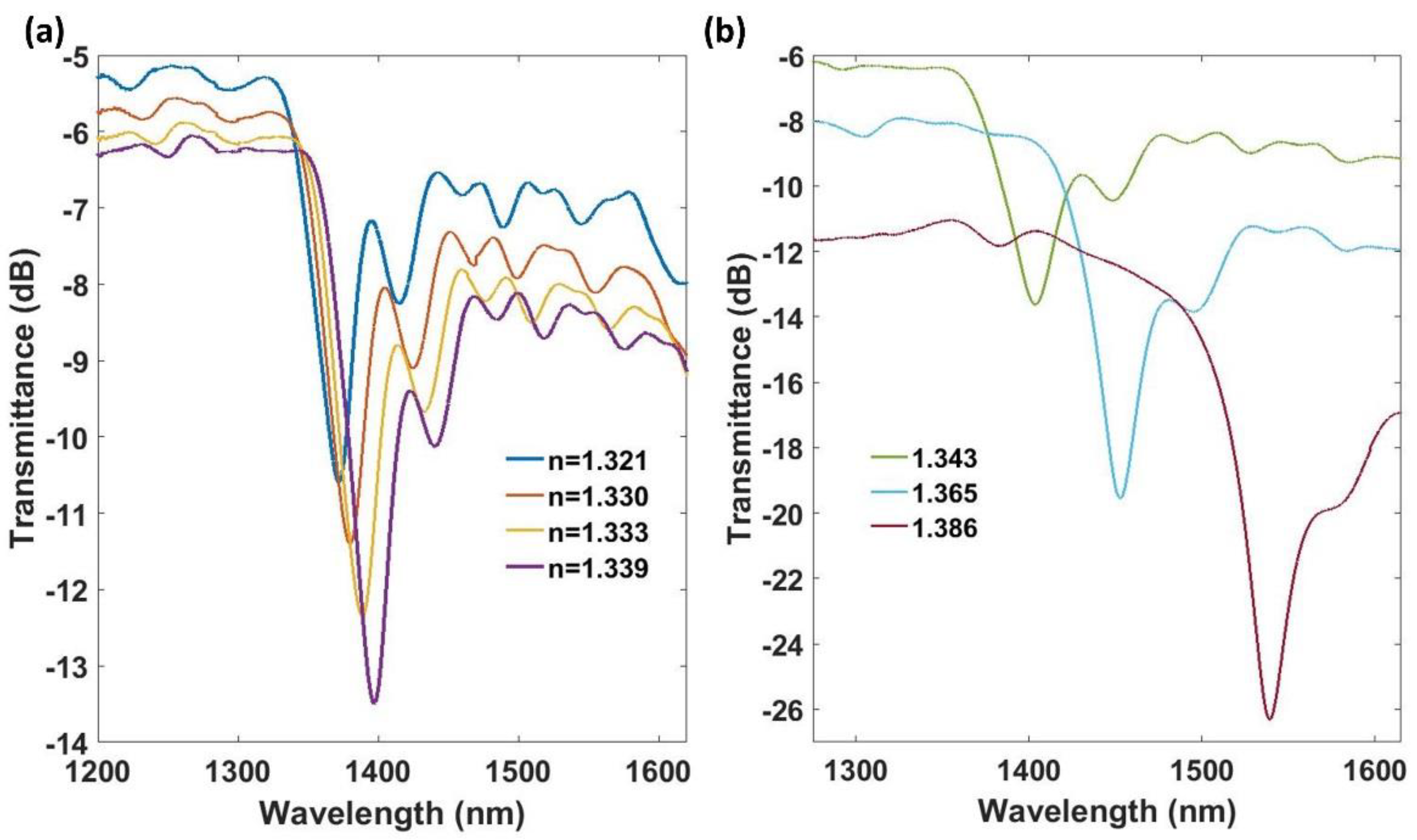

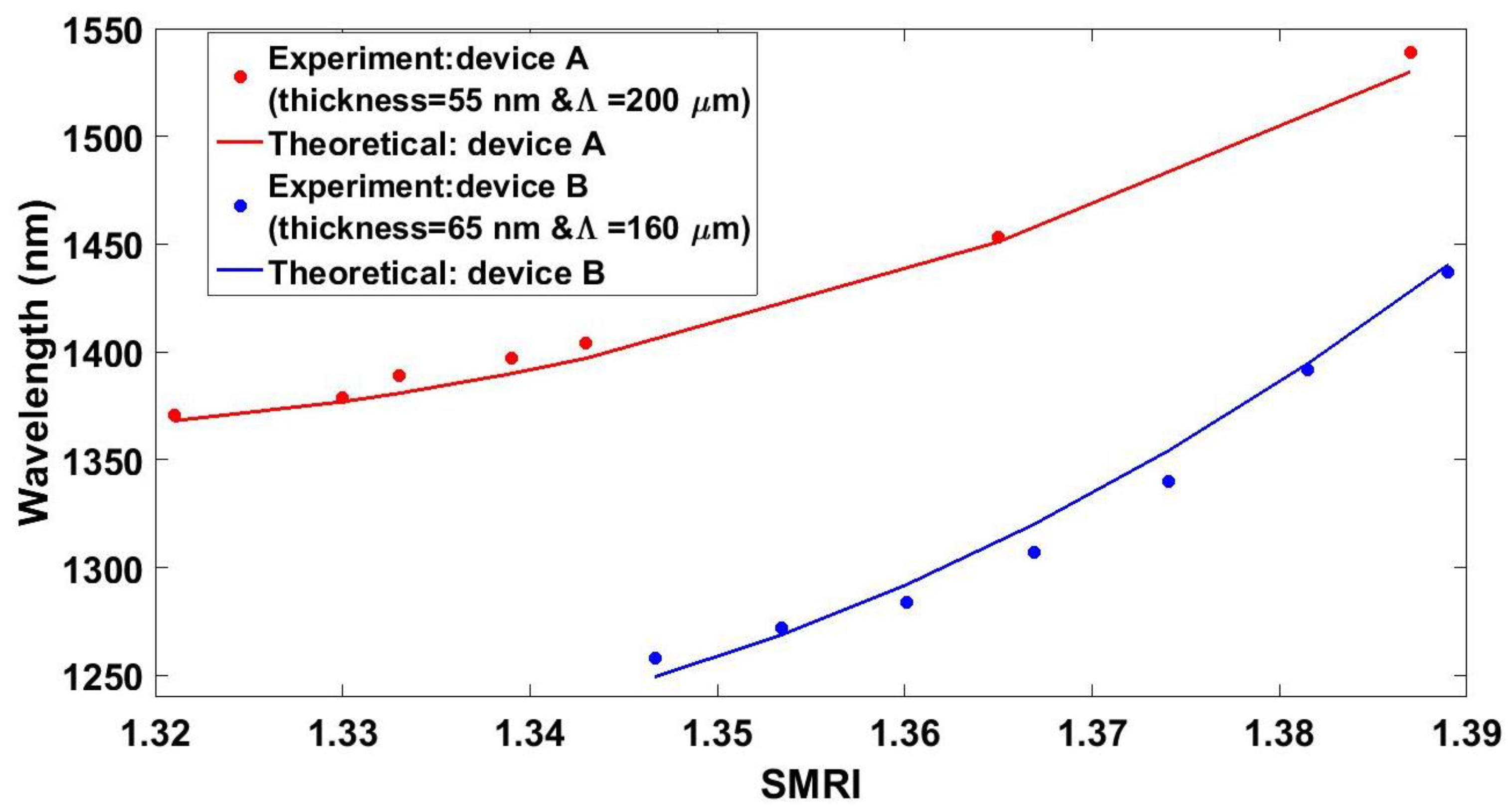
© 2018 by the authors. Licensee MDPI, Basel, Switzerland. This article is an open access article distributed under the terms and conditions of the Creative Commons Attribution (CC BY) license (http://creativecommons.org/licenses/by/4.0/).
Share and Cite
Ascorbe, J.; Corres, J.M.; Del Villar, I.; Matias, I.R. Fabrication of Long Period Gratings by Periodically Removing the Coating of Cladding-Etched Single Mode Optical Fiber Towards Optical Fiber Sensor Development. Sensors 2018, 18, 1866. https://doi.org/10.3390/s18061866
Ascorbe J, Corres JM, Del Villar I, Matias IR. Fabrication of Long Period Gratings by Periodically Removing the Coating of Cladding-Etched Single Mode Optical Fiber Towards Optical Fiber Sensor Development. Sensors. 2018; 18(6):1866. https://doi.org/10.3390/s18061866
Chicago/Turabian StyleAscorbe, Joaquin, Jesus M. Corres, Ignacio Del Villar, and Ignacio R. Matias. 2018. "Fabrication of Long Period Gratings by Periodically Removing the Coating of Cladding-Etched Single Mode Optical Fiber Towards Optical Fiber Sensor Development" Sensors 18, no. 6: 1866. https://doi.org/10.3390/s18061866
APA StyleAscorbe, J., Corres, J. M., Del Villar, I., & Matias, I. R. (2018). Fabrication of Long Period Gratings by Periodically Removing the Coating of Cladding-Etched Single Mode Optical Fiber Towards Optical Fiber Sensor Development. Sensors, 18(6), 1866. https://doi.org/10.3390/s18061866






